A commercial kitchen consists of a complex system of HVAC, plumbing, and electrical components. One of the most critical and difficult parts of a commercial kitchen is the HVAC system. Your commercial kitchen can’t operate without a system that’s up to code and expertly installed.
You need to know many things when designing the HVAC system for your commercial kitchen, and it will require the knowledge and experience of an HVAC professional. Only they have the tools and expertise necessary to ensure that your system is big enough to keep your kitchen clean and protected. Installing a system that’s too small or not appropriately designed will result in a world of trouble for you and your employees.
In this article, I’m going to go into great detail about your commercial kitchen’s HVAC system and each of the components that make it up. Commercial kitchen heating and cooling systems use similar concepts as a residential property, but there are different rules and types of equipment. For this reason, unique licensing is usually required to install commercial HVAC systems.
What Are The Components of a Commercial Kitchen’s HVAC System?
Let’s start by first looking at the components that make up a commercial kitchen HVAC system. You’ll likely recognize some of the items, but not all of them. Commercial properties often use materials and products different from residential properties. Ensure that the HVAC technician you hire for your commercial project is adequately licensed to complete the job.
The Furnace/Furnaces

Depending on how large your kitchen is, you’ll need more than one furnace. You usually require multiple furnaces because of how high most commercial ceilings are and how big the kitchens are.
The furnace is the component that’s responsible for producing heat during the winter months. It also contains the fan or blower, which is responsible for blowing air through your ductwork and into your kitchen. An HVAC system is incomplete without these two essential components.
The Air Conditioner/Air Conditioners
The air conditioner generates ice-cold air that gets dispersed into the kitchen courtesy of the blower fan and the ductwork. Your air conditioner works in tandem with the refrigeration lines and the A-coil connected to the furnace to cool air. There is a refrigerant that gets cooled down by the air conditioner. The refrigerant then flows through refrigerant lines and into the A-coil on the furnace.
The refrigerant in the A-coil then cools down the air that’s flowing over and through it as it gets pushed by the blower fan through the ductwork. Every part of the ventilation system has to work together to generate cold air and disperse it through your kitchen. There is one air conditioner for every furnace in your kitchen.
The Ductwork
The ductwork is the metal pipes or boxes connected to your furnace, and they’re responsible for pushing and pulling air through your kitchen. Every HVAC system will have two sets of ductwork connected to the furnace. One set of ductwork is the supply of hot air duct, and its’ job is to push air from the furnace into your kitchen. The other set of ducts, known as the return or cold air ducts, pulls air out of your kitchen and has it flow back to the furnace.
The air in this ductwork then gets recycled and purified by an air filter before making its return journey to the kitchen.
The return journey gets made via the set of ducts that is pushing air into the kitchen. A common misunderstanding that many people have is that your furnace doesn’t create an atmosphere. It works by pulling air out of the kitchen via the return or cold air ducts and then pushing it back through the supply of hot air ducts.
The Furnace Filter
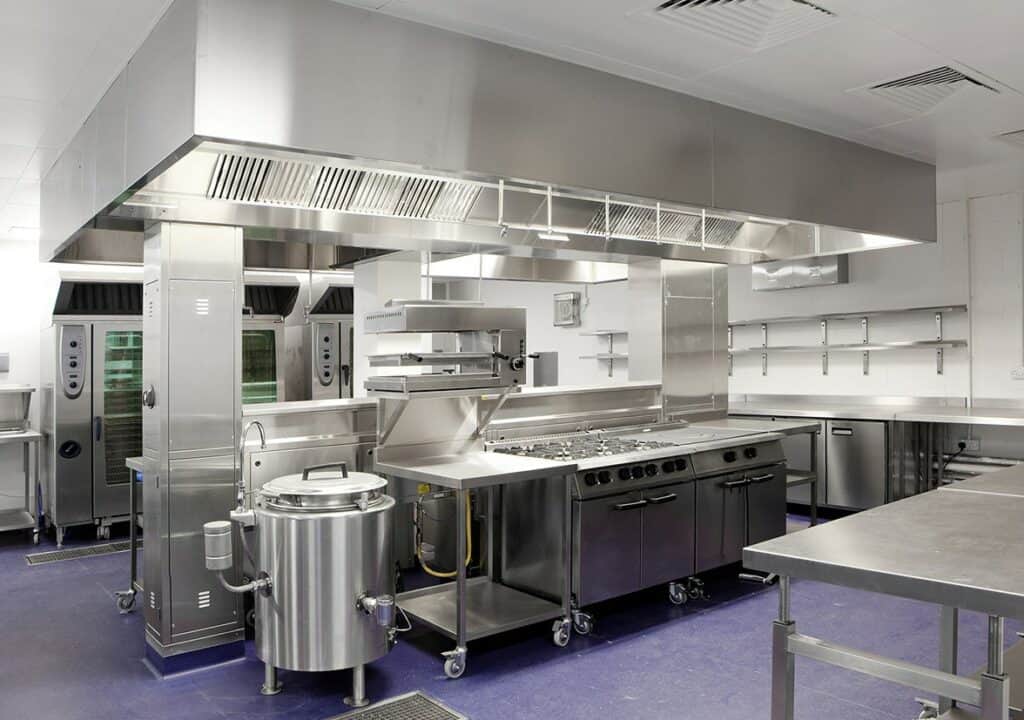
Because it’s recycled air that’s flowing through your ductwork and into your kitchen, it must get cleaned somewhere along the way. You don’t want to pull dirty air out of your kitchen and put it right back in while it’s still dirty. That’s where the furnace filter comes into play. Each furnace in your kitchen will have an air filter located between the furnace itself and the ductwork that’s sucking the air out of the kitchen.
The air flows through the furnace filter, which removes any dirt or harmful particles from the air. The clean and recycled air then flows back down the supply ductwork and into your kitchen.
The Thermostat/Thermostats
A physically small but essential part of your HVAC system is the thermostat. It’s responsible for managing and regulating the temperature of your kitchen and determines how hot or cold it is. Thermostats can now even decide if your air conditioner or furnace needs to run.
There are also thermostats called “learning thermostats” or “smart thermostats” that learn what setting and temperature you want your kitchen to be at different parts of the day and times of the year. The thermostat then adjusts itself without any help from you.
If your thermostats aren’t in good working order, then neither will your furnace or air conditioner.
The Makeup Air
Makeup air vents, also known as fresh air vents, are duct systems that are connected between your return air ductwork and the outside of the building. Commercial kitchens are required to have at least one makeup air vent because the furnace filter isn’t capable of thoroughly cleaning the filthy air in your kitchen.
Think about it. There is grease, oil, food particles, smoke, and a variety of other nasties floating around in the air at all times. A makeup air vent gets designed to bring fresh air in from the outside of the building and make the job of your furnace filter a little easier.
The Air Vents
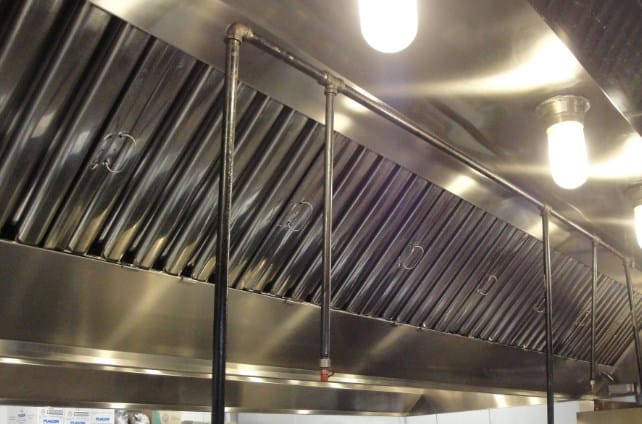
The air vents are the circular or rectangular registers located throughout your ductwork. The way that air circulates through the ventilation system is via the air vents. Both your supply air ductwork and return air ductwork will have air vents, allowing air to enter and exit the system.
There are two basic types of air vent distribution: branch ductwork or direct ducting.
Branch system ductwork
For this type of ventilation system, there are a series of smaller duct pipes that branch off of the main duct line. It’s similar to how smaller side roads connect to the main road. The smaller duct pipes then travel to different parts of your kitchen in an attempt to evenly disperse air throughout it.
Direct ducting
Direct ducting is where there aren’t any smaller duct pipes branching off of the primary system. Instead, the air vents or registers are cut directly into the central ductwork, and the air gets dispersed throughout your kitchen in that manner.
The Indoor A-coil/coils
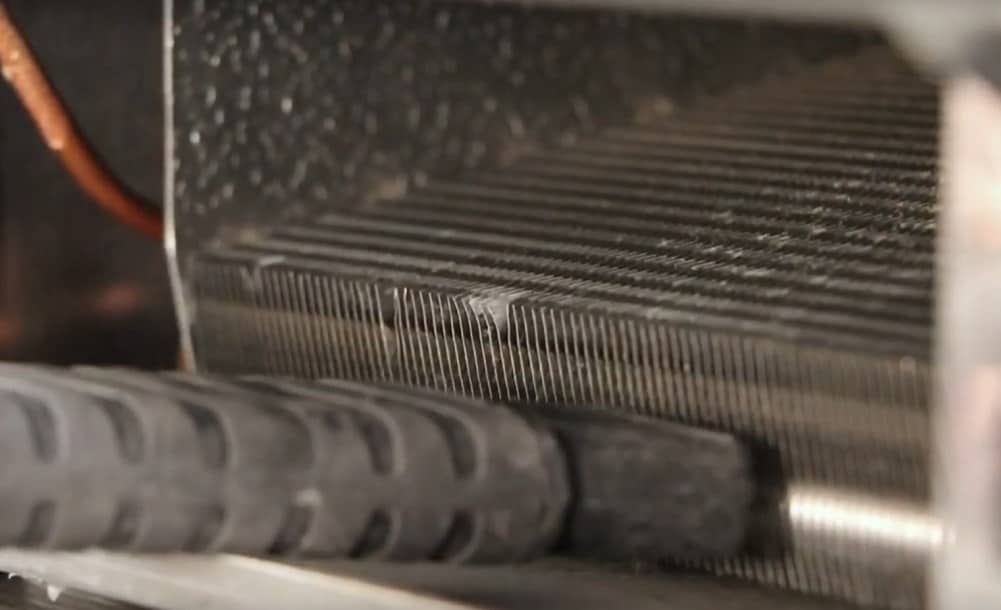
Like I said before, the indoor A-coil is attached to your furnace inside the building. The A-coil works in tandem with the air conditioner and refrigerant lines to facilitate refrigerant flow back and forth between it and the air conditioner. As the air in your furnace flows over the ice-cold A-coil, it gets pushed through the ductwork into your kitchen.
The Refrigeration Lines
The refrigeration lines are the copper pipes running between the air conditioner and the A-coil. The refrigeration lines are responsible for transporting refrigerant back and forth between the two units and keeping it ice-cold. Each air conditioner will have two refrigeration lines connected to it—one to take refrigerant into the A-coil and one to bring it back.
Alternatively, The Rooftop Unit
Another option is to have a rooftop unit rather than have a furnace, an air conditioner, refrigeration lines, an A-coil, and a furnace filter all separate from each other. A rooftop unit combines all of these different components into one package, and it all sits on top of your roof or next to your building. It’s called a rooftop unit, but you can put it wherever you want outside of your structure.
A rooftop unit will still have supply air ductwork and return air ductwork that works the same way with a standard HVAC system. The rooftop unit will also have a thermostat that controls the air temperature that gets dispersed throughout your kitchen.
Other Components of the HVAC System
Some of the parts that people often forget are included in the HVAC system of a commercial kitchen include range hood exhaust fans, range hood exhaust ducting, and kitchen exhaust fans. They sometimes get overlooked because they aren’t the furnace, air conditioner, and ductwork commonly associated with HVAC systems. However, as this article continues, I’ll lay out the importance of always including these items in your commercial kitchen.
Pros and cons of a rooftop unit
Pros
They’re often more efficient than other systems
Because rooftop units are made and designed in a factory and don’t rely on outside help to operate and calibrate, they’re often more efficient than standard heating and cooling systems.
Take up less space than other systems
Rooftop units are ideal for commercial kitchens because they don’t take up any interior space. Commercial kitchens require as much space as possible for the use of machinery, and having a furnace with ductwork can muck things up. Rooftop units are out of sight and out of mind.
The ease of installation isn’t comparable
They’re also much easier to install than traditional heating systems. You don’t have to worry about running refrigeration lines from the air conditioner to the furnace or running an electrical wire to both the furnace and air conditioner. All that a rooftop unit requires for operation is a return air duct and a supply air duct, and a single electrical hookup. You could save a bunch of money with installation costs.
There are fewer things that can go wrong
Because everything is contained right there in one place, there are fewer risks of something getting damaged.
Cons
There’s no protection from exposure to the elements
The biggest downside of rooftop units is that there’s no way to protect them from the elements. Rain, sleet, snow, and heat will all bear their full wrath on your rooftop unit, which could potentially reduce its lifespan. It’s essential to have a rooftop unit checked and serviced regularly.
More vulnerable to damage from other outside threats
Aside from the weather elements, there are plenty of other things that can damage a rooftop unit. It’s not unusual for birds and small animals to make nests in or near rooftop units, and there’s a risk of damage when they do so.
It is challenging to replace and service when the time comes
Because they’re often located on a roof, this type of unit takes longer to service because of the difficulty of gaining access. Rooftop units are also challenging to replace because you often need a crane to haul the old unit off a roof and put the new one on.
You can’t use them everywhere
If your commercial kitchen happens to be in the middle level of a multi-level building, a rooftop unit isn’t an option. You have to have clear access to a roof or the ground for a rooftop unit to be applicable.
Range hoods for commercial kitchens
Something that often gets overlooked is the installation of the range hoods for each of your commercial kitchens stoves.
You can’t have a series kitchen without good stoves, and you can’t have good stoves without range hood vents. Or can you? You have to option of using a ducted range hood or a ductless one. I’ll explain both of them in detail below. Suffice it to say, however, that you need one or the other to operate a commercial kitchen range or stove successfully.
Ducted Range Exhaust Hoods
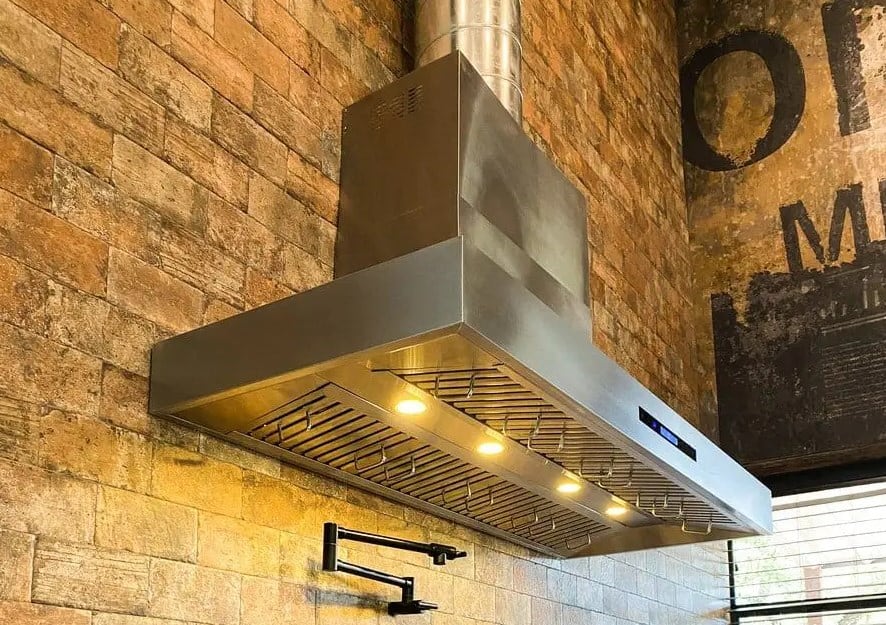
A ducted range exhaust hood is often considered the more effective of the two exhaust options. There is a range hood located above the range, and there’s a duct connected to the top or back of the hood. The duct connected to the range hood terminates to the outside of the building. Air and grease get sucked through this duct system and expelled outside of the kitchen and building through the duct.
This system is essentially an exhaust fan that sucks air from one place and pushes it to another location. The only difference is that range exhaust hoods are specifically designed for ranges and stoves.
Advantages of a Ducted Range Exhaust System
- This system is widely regarded as more effective than the alternative because it removes contaminated air from the kitchen. It doesn’t try to recycle it and push it back into the kitchen.
- The shorter your exhaust pipe is, the better. Your exhaust system isn’t designed to carry air and contaminants for long periods. Keeping the route from the range hood to the exterior of the building as short as possible will generate the best results.
- Overall, a ducted exhaust system will do a much better job of keeping your kitchen as clean and safe as possible.
Disadvantages of a Ducted Range Exhaust System
- While this type of exhaust system is more effective, it’s also more expensive to install. You can expect to pay around a thousand dollars to have this system installed.
- There’s also a chance that a ducted system will be louder than one that isn’t ducted. Noise isn’t always a significant factor in a kitchen since it’s usually noisy, but you should opt for the less noisy option if it is a concern.
- A ducted exhaust system also takes up a little more space than alternative systems do.
Ductless or Ventilated Range Hoods

A ductless or ventilated range hood is pretty standard in residential homes and smaller kitchens. This type of system doesn’t have an exhaust pipe running from the kitchen to the outside of the building and is, therefore, easier to install.
The way that a ductless system works is by having a range hood that sucks air into it. Inside the range hood, special filters clean and purify the air as best as possible before recirculating it throughout the kitchen.
This system is similar to how your furnace system works by sucking air through the return air duct, purifying it with the furnace filter, and redistributing it through the supply air duct. A ductless exhaust system gets the job done of somewhat cleaning the air, but it will struggle to perform as well as a ducted exhaust system.
However, they’re ideal for situations where a stove isn’t close to an outside wall, and there’s no way to run a duct pipe to the outside of the building.
Commercial Kitchen Exhaust Fans
Another critical component of your kitchen’s HVAC system is the proper installation of commercial kitchen exhaust fans.
These types of fans work similarly to how your range hood exhaust system works. The most significant difference is that range hood exhaust systems are often designed specifically for stoves. In contrast, kitchen exhaust fans are usable in a wide range of areas.
There are also different types and sizes of kitchen exhaust fans. There are so many kinds of fans and installation methods so that there’s a fan for every situation. Let’s take a look at the different types of kitchen exhaust fans.
Different Types of Kitchen Exhaust Fans
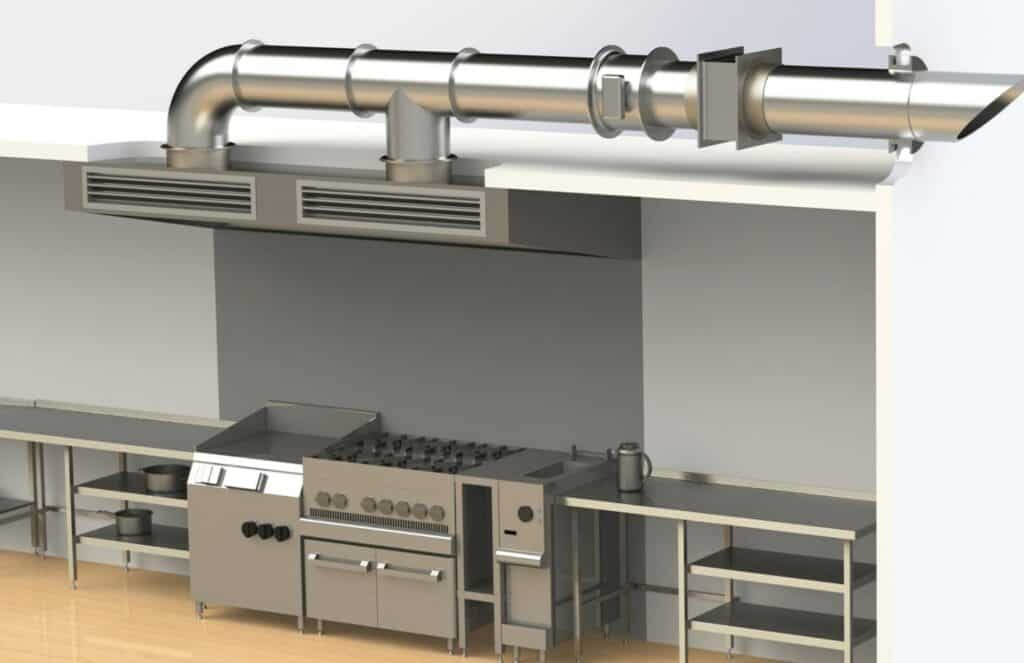
Type 1
Type 1 exhaust fans are often referred to as “grease hoods” and are often used above grills, cooktops, stoves, and other appliances that generate high heat and grease. Range exhaust fan systems fall into this type of kitchen exhaust fan.
Type 2
Type 2 exhaust fans are similar to Type 1 fans except that they’re implemented differently. Type 2 fans are typically used above things that generate steam and condensation rather than grease. Things like dishwashers, pasta cookers, rice cookers, and anything else that produces steam should have a Type 2 exhaust fan nearby.
Wall canopy
Wall canopy hoods are Type 1 or Type 2 hoods and are named wall canopy hoods because of where you install them. It should come as no surprise that this type of hood is what you will install against a wall, usually above a stove or dishwasher.
Island canopy
Once again, this type of hood is a Type 1 or a Type 2 hood, and “island” refers to where you install it. Not all steam or grease-producing appliances are located along walls, and it’s common for island canopy hoods to be used above frying stations or cookers that produce steam.
Low proximity
Low proximity hoods are Type 1 or Type 2 exhaust hoods and are perfect for tight areas with limited space. If an area of your kitchen has a low ceiling or is simply in a tight spot, low proximity hoods are perfect.
Just as with range exhaust systems, you have the option to use a ductless exhaust system or a ducted one with your kitchen exhaust fan. The principles are the same in both cases. Ducted kitchen exhaust fans do a better job of completely getting rid of grease, moisture, dirty air, and other nastiness in your kitchen. Ductless kitchen exhaust fan systems use carbon filters to purify the air and recirculate it back into your kitchen.
The type of fan you choose for your kitchen is entirely up to you, but ducted ones are better for overall air quality.
Kitchen Exhaust Fan Size and Placement
You mustn’t have random exhaust fans installed throughout your kitchen. Each fan should be the correct size and in the right location to be effective at keeping the air in your kitchen clean. The size and power of your kitchen exhaust fan are measured in CFMs.
For smaller appliances and areas of your kitchen, an exhaust fan with exhaust rates of 150 to 300 CFMs is sufficient. For medium-sized appliances such as fryers, griddles, and ranges, you should upgrade to a 150 to 400 CFM exhaust fan. Larger appliances such as woks and charbroilers require the most enormous exhaust fans, which weigh in at 200 to 600 CFMs.
It’s crucial that you place kitchen exhaust fans as close to the appliances that need them as possible. Having them positioned randomly in the middle of your kitchen will move air around, but it won’t be as effective as if the fan were directly above a grease or steam-producing appliance.
Signs and Symptoms That a Commercial Kitchen HVAC System Needs an Upgrade
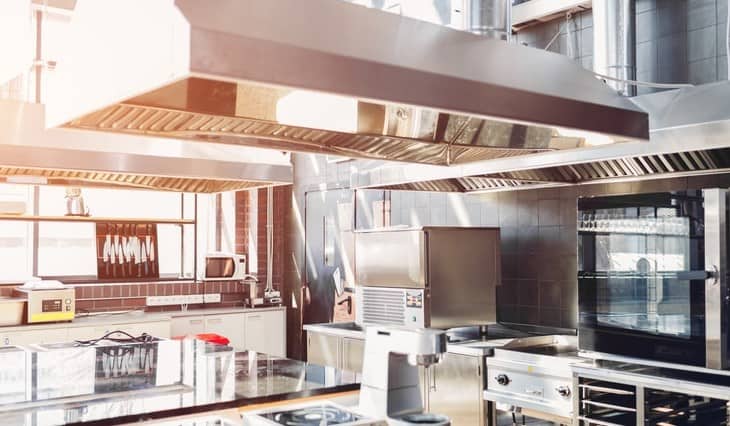
If your kitchen is old or outdated, there’s a good chance that you need an upgrade. Kitchen codes and regulations are constantly changing, and it’s hard to keep up with all of the requirements. Here are a few sure-fire ways to know if your kitchen’s HVAC system needs an upgrade.
A major part of your system is damaged
If your air conditioner or furnace is constantly breaking down or experiencing issues, it might be time to update your entire system. Depending on how old and how many problems your mechanical components have, an experienced HVAC technician will recommend replacing the system rather than repairing it.
There are buildups of grease and oil throughout your kitchen
Kitchen exhaust fans and range hood exhaust systems are meant to extricate grease and moisture from your kitchen. If you notice buildups of grease, moisture, or oil, there’s obviously a problem with your exhaust system. You should either upgrade to newer and larger exhaust fans or consider adding a few more to your kitchen.
Trouble regulating temperature
Not being able to regulate the temperature in your kitchen is one of the most common signs that you need to change something with your HVAC system. Either your system isn’t big enough to keep up with your kitchen’s demands, or there’s a problem with the airflow. Either way, you should have a service technician come out and inspect your HVAC system.
Higher than usual energy bills
Unusually high energy bills mean that your furnace or air conditioner is running more than it should.
Smoke and strange smells
Once again, the whole point of having exhaust fans in your kitchen is to prevent clouds of smoke and nasty smells from ruining your kitchen. A smoky or stinky kitchen is an indicator that you should upgrade your HVAC system.
Your thermostats are old and outdated
Most HVAC technicians will recommend that you install smart or learning thermostats in your kitchen. The temperature fluctuates so much in commercial kitchens that it’s essential to have a thermostat that thinks for you. You can program a smart thermostat to adjust the temperature periodically throughout the day automatically.
Your HVAC system is too small
If your energy bills are high or if you have trouble regulating temperature, the odds are that your system is too small. As HVAC systems get older, they start to work slower and have trouble keeping up. It’s important that you pay attention to the atmosphere of your kitchen and know when it’s time to go up a size in your furnace and air conditioner.
FAQs
Question: Do I always need a makeup or fresh air system in my commercial kitchen?
Answer: Depending on where your commercial kitchen is located, a makeup air system isn’t always required. However, it’s always a good idea to install one, no matter what. Exhaust fans and your furnace and ductwork do all they can to keep the air in your kitchen clean and fresh. Unfortunately, because of the large amounts of smoke, grease, and food particles that get released into the air, it’s nearly impossible for them to keep up. A makeup air system is a great way to boost the quality of air in your kitchen.
Question: Is it possible for an HVAC system to be too big?
Answer: Yes, in the same way that you can have a system too small for your kitchen, you can also have one that’s too big. A system that’s too big will run less frequently and for shorter periods of time. As a result, it will struggle to reduce the humidity of your kitchen, and your staff will be quite uncomfortable.
Question: Can someone licensed to install residential HVAC systems install my commercial HVAC system?
Answer: It all depends on where you’re located in the country. Certain building codes don’t require special licensing for residential versus commercial HVAC. However, whether your HVAC installer is licensed or not, you should always pick someone that’s licensed and experienced with installing commercial kitchen HVAC systems.
Question: How much does it cost to install a commercial HVAC system?
Answer: Commercial kitchen HVAC systems are quite costly to install. You can expect to pay anywhere from $5,000 to $30,000 depending on how large your kitchen is and how many systems you need. It also depends on how many range hoods and kitchen exhaust fans you need throughout your kitchen. The more bells and whistles you have and the larger your kitchen, the more you can expect to pay.
Question: How long should an HVAC system last in my commercial kitchen?
Answer: Your system will last longer the better you care and maintain it. If you have your HVAC system, exhaust fans, and range hood vents cleaned and checked regularly, they will last 20 to 40 years or more. If you don’t keep them cleaned and maintained and if your system is too small for your kitchen, your furnace, air conditioner, and fans can give out in as little as 5 to 10 years. You should also consider having your ductwork and exhaust duct systems cleaned and checked on a regular basis.
Commercial Kitchen HVAC Guide: Final Thoughts
If you’re planning to open or remodel a commercial kitchen, it’s essential that you have the proper HVAC system installed. By following the steps and reminders in this article, you’ll be well on your way.
Always remember that proper ventilation of your kitchen appliances and keeping your kitchen as dry and clean as possible is most of the battle. If you’re able to do these things and have a licensed professional install your HVAC system, your kitchen will be the envy of all other kitchens.
